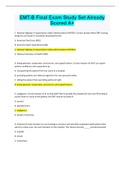Samenvatting
Summary Economics for the Gobal Era - preview version (IBA VU Amsterdam)
- Instelling
- Vrije Universiteit Amsterdam (VU)
This summary is a preview edition for the first year course Economics for the Global Era of BSc International Business Administration VU Amsterdam. This preview consists of chapter 17 and 19.
[Meer zien]














